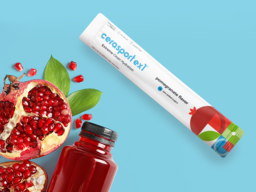From the archives: Profiting by Doing Good
December 07, 2015
From the archives: Profiting by doing good
Profiting By Doing Good
The Baltimore Sun • Baltimore, MD • February 7, 1999 • By Mark Guidera, SUN STAFF
An idealistic Columbia woman is pushing a product that she believes can save thousands of lives from deadly dehydration.
Charlene B. Riikonen dreams of the day her company’s packets of a powdered electrolyte drink are commonly found in the medicine cabinets of America -- and in the wilds of Bangladesh and Uganda.
Riikonen is co-founder and president of closely held Cera Products Inc., which markets electrolyte products that help people avoid serious illness and death from fl uid and electrolyte loss through diarrhea and other afflictions.
Several hundred children die annually in the United States from diarrheal dehydration, most in rural areas with poor health services. Worldwide, an estimated 4 million to 5 million people die annually from dehydration.
“It’s the silent killer you never hear about,” says Riikonen.
Her answer is CeraLyte, a powdered drink developed with the help of two Johns Hopkins University researchers.
The rice-based powder, which contains seven times the potassium and four times the sodium as Gatorade, can be mixed with water, Kool-Aid, tea or other fl uids to make an electrolyte solution that quickly restores the bodily fluids and chemical balance. Initially developed for adult use, CeraLyte also comes in a formulation for children.
Despite a huge market -- there are an estimated 50 million to 100 million cases of diarrhea annually just in the United States -- it’s been tough going for Riikonen and the Jessup company she helped launch in 1993.
But the Columbia resident says the prospect of saving lives makes the quest worthwhile.
“I’m interested in making a difference, not just a dollar,” said Riikonen, who saw firsthand how dehydration can cause severe illness and death during a three-year stint in Bangladesh with an international health group.
Cera Products is tiny compared to the giants in the electrolyte drink market for children and athletes. Abbott Laboratories’ Pedia- Lyte dominates the children’s market with a 90 percent share, while Mead Johnson’s InfaLyte has about 8 percent.
Gatorade, also used for rehydration, is the undisputed champion of the sports drink market with more than $1.3 billion in world sales in 1998.
Despite such rivals, Riikonen, a former University of Maryland public relations administrator, has built a customer list that includes Johns Hopkins Medical Center, the Mayo Clinic, Tufts University Medical Center, Dartmouth College’s Hitchcock Medical Center, and St. Luke-Roosevelt Hospital in New York.
The company reached the break-even point last year on sales of about $700,000, said Riikonen. That might not seem like a lot, but it’s light years ahead of the company’s first-year sales of $6,800 in 1996.
While the executive has a command of company sales growth fi gures and distribution agreements -- the company contracts for the manufacturing of its products and relies on medical supply companies to help sell them -- few subjects get her more excited than stories of CeraLyte helping sick people feel better.
They included the severely dehydrated children treated by Hopkins doctors in Uganda and a Louisiana woman bedridden from short bowel syndrome. The woman wrote the company a lengthy letter describing how she’d been listless with dehydration after surgery until using CeraLyte. The drink, she said, got her back to work within days.
`Helping people’
“To me, it’s those kind of stories that tell me we have the right products and are doing the right thing. We’re making money while helping people,” said Riikonen.
The health group that employed Riikonen in Bangladesh in the 1980s found that one of the best treatments for diarrheal dehydration was oral rehydration therapy, or ORT. Local health workers and villagers could be taught easily how to mix a batch of a rehydration formula that was developed in 1971 to treat the millions of sick and dying refugees that fled the Bangladesh-Pakistan war.
Riikonen and Dr. William B. Greenough III, a Johns Hopkins gerontologist and international health expert for whom she worked in Bangladesh, began trying to develop an advanced ORT solution that would work faster and better than the glucose-based solutions. “We came up with a lot of things that when you mixed them with water, the powder sort of just fl oated right to the top and stayed there,” recalls Riikonen. “It took a lot longer than we initially thought to come up with something that was drinkable and that worked.” It took almost three years. Greenough and a Hopkins colleague, Dr. David Sack, focused on a rice-based mix that became the foundation for Cera’s line of products.
Through experiments, Greenough and Sack said they found that long-chain carbohydrates in rice speed the absorption of fluid and electrolyte salts into the body’s cells.
Today, medical institutions such as Hopkins and the Mayo Clinic use CeraLyte to treat patients suffering from severe diarrhea. Some also use it to treat elderly patients and dehydration cases stemming from cancer, AIDS and inflammatory bowel diseases.
Dr. Michele Bellantoni, an assistant professor of medicine at Hopkins and medical director for long-term care at the Johns Hopkins Geriatric Center, said the center often distributes packets of CeraLyte to outpatients suffering from diarrhea and other gastrointestinal disorders.
The aim is to prevent serious dehydration and its side effects, such as high blood pressure, dizziness and heart attack. “What a lot of people don’t realize is that many of the common home remedies, such as Coke and sodas, can actually make the situation worse because of the high sugar load,” she said. “We like CeraLyte because it’s rice-based and has the right proportions of carbohydrates and salts.”
Bellantoni said he believes the product will fi nd wider acceptance among physicians as it becomes more commercially available in drugstores and other retail outlets.
Building staff
Cera Products plans to hire a sales director this month to build distribution among retail outlets. The company also plans to hire a business development director and a customer service representative.
The company has agreements with medical suppliers to distribute CeraLyte in Europe and Latin America. And it’s working on distribution agreements with suppliers in Hong Kong and the Middle East, including Israel. Riikonen, who has pretty much run the company on her own for fi ve years, hasn’t given up on her goal of getting CeraLyte distributed in countries like Bangladesh. For now, though, she’s focused on building U.S. sales and reaching agreements with companies that have marketing and distribution networks.
A niche the company has recently begun to tap is the traveler’s market. Magellen’s, one of the largest retailers of travel supplies, and TravelMedicine Inc., a mail-order house, have begun selling travel kits that contain CeraLyte packets.
First big contract
Two years ago, Cera scored its fi rst big contract, supplying electrolyte powder to a sports nutrition company for a product marketed to body builders. Though lucrative for Cera, Riikonen and Greenough recently decided not to renew the contract because the sports nutrition company was adding a muscle booster to the mix.
Instead, Cera came up with its own CeraSport citrus-flavored sports drink powder.
Marketing CeraSport to sports teams, even at the college and high school levels, proved diffi cult because an increasing number of schools have exclusive supply agreements with Coca-Cola Co. and Pepsi Co., respectively the makers of SportAde and AllSport.
The company is seeking a sports marketing partner with an established sales and distribution network, said Riikonen. Cera, she said, is in discussions with several potential partners. Gary Hemphill, vice president of Beverage Marketing Corp., a New York fi nancial consultant to the beverage industry, said niche players like Cera have to find a marketing edge. “It’s very tough to compete and be successful in the same arena as Gatorade.
Even Coke and Pepsi haven’t been able to topple Gatorade’s dominance,” said Hemphill.
Still, Riikonen and Greenough are bullish on the outlook for Cera Products, particularly for their core product,
CeraLyte. “Like a lot of small companies, Cera is always struggling with capitalization. We don’t have a big advertising and marketing budget,” said Greenough, a director and shareholder of the company.
“But I think over time, as word gets out that CeraLyte is an advanced oral rehydration product that really helps people recover quickly, it will end up as a staple in people’s medicine cabinets at home.”
State economic development offi cials think the company’s products, particularly the rehydration formula and another being developed as a vaccine booster, have the potential to be successes if not blockbusters.
“When Charlene fi rst came to us, she had a great business plan and already had CeraLyte on the shelves at Hopkins,” recalled Daniel P. Healey, associate director of the Investment Financing Group at the Maryland Department of Business and Economic Development, which in 1996 awarded a $50,000 challenge grant to Cera.
`Compelling story’
“It was a compelling story. In effect she had an adult form of PediaLyte with a strong intellectual property position. It’s a niche market with a lot of potential.”
Healey and Ronald M. Blank, director of the state agency’s Investment Financing Group, see Cera at a crossroads.
For one, they believe the company needs to add management and marketing talent while aggressively seeking marketing partners with a strong U.S. distribution network. “Charlene is a starter and has the tenacity of a bulldog,” said Blank.
“Adding management talent would bring a new dimension to the company so that it can be a runner and a finisher.”
Given growth in sales, new product licensing agreements and added management, the company could be a candidate for the state’s enterprise investment program, under which the state takes an equity stake in a company of up to $500,000, said Blank.
It’s also hoping to see a strong revenue stream from a recently signed licensing deal with Nutramax Laboratories Inc. of White Marsh, which is offering the electrolyte product in a formula for puppies and kittens. Nutramax, a nutritional supplements company, is marketing the product, Ritrol, directly to veterinarians.
Riikonen and Greenough also are optimistic about VacX, the rice-based electrolyte formula that boosts the effectiveness of an experimental oral live cholera vaccine by speeding transfer of the vaccine out of the acidic environment of the stomach, which degrades some oral vaccines.
Sack, a professor of tropical diseases, said he found in his experiments that antibody responses were three times higher in healthy volunteers given the vaccine with VacX (pronounced vax), compared with those given the vaccine without the booster.
The researcher is now planning new experiments to see if VacX could be useful as a booster for other oral vaccines, such as polio vaccine.
Meanwhile, the Army is testing VacX to see if it boosts the effectiveness of drugs to treat intestinal disorders.
Said Greenough, “There’s a lot of serendipity involved with how we came across the vaccine booster. But a little serendipity can go a long way for a small company.
Share:
Leave a comment
Comments will be approved before showing up.



